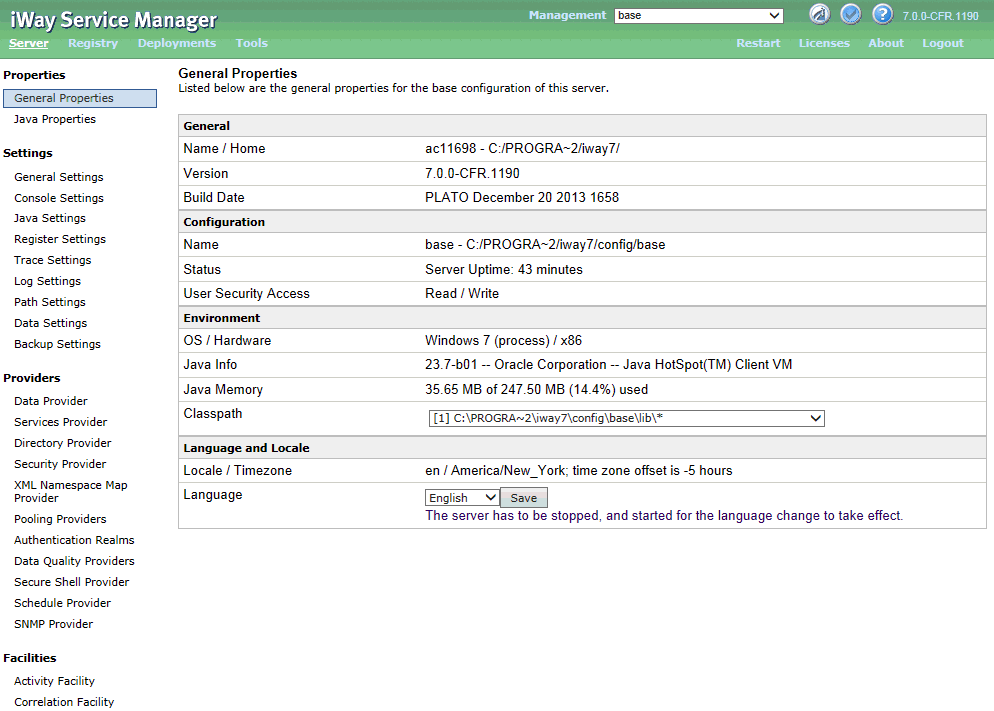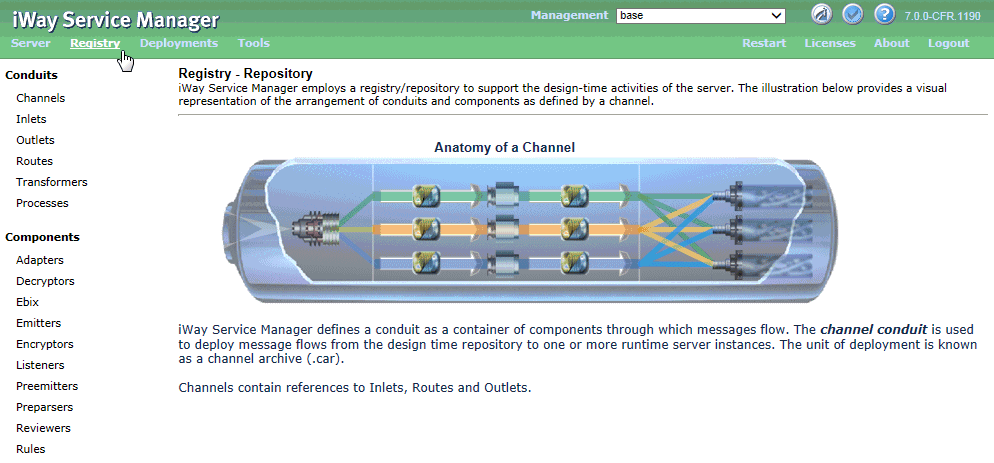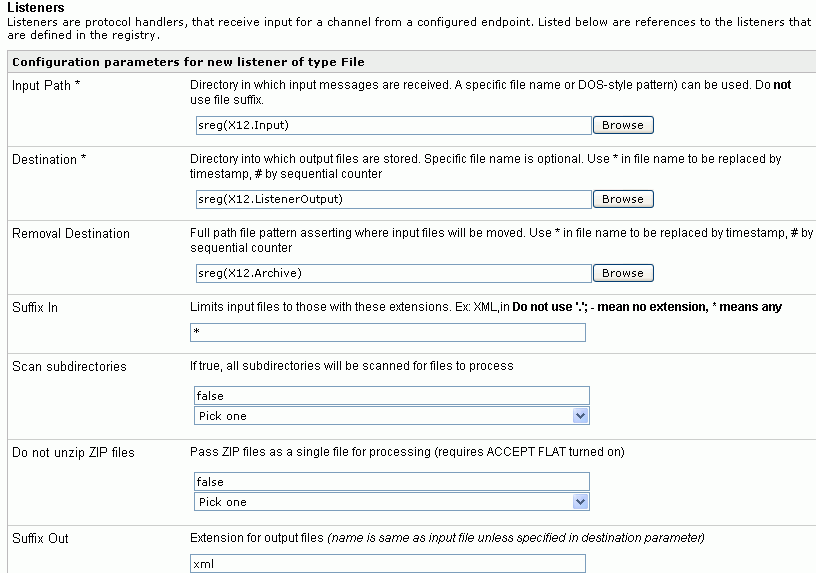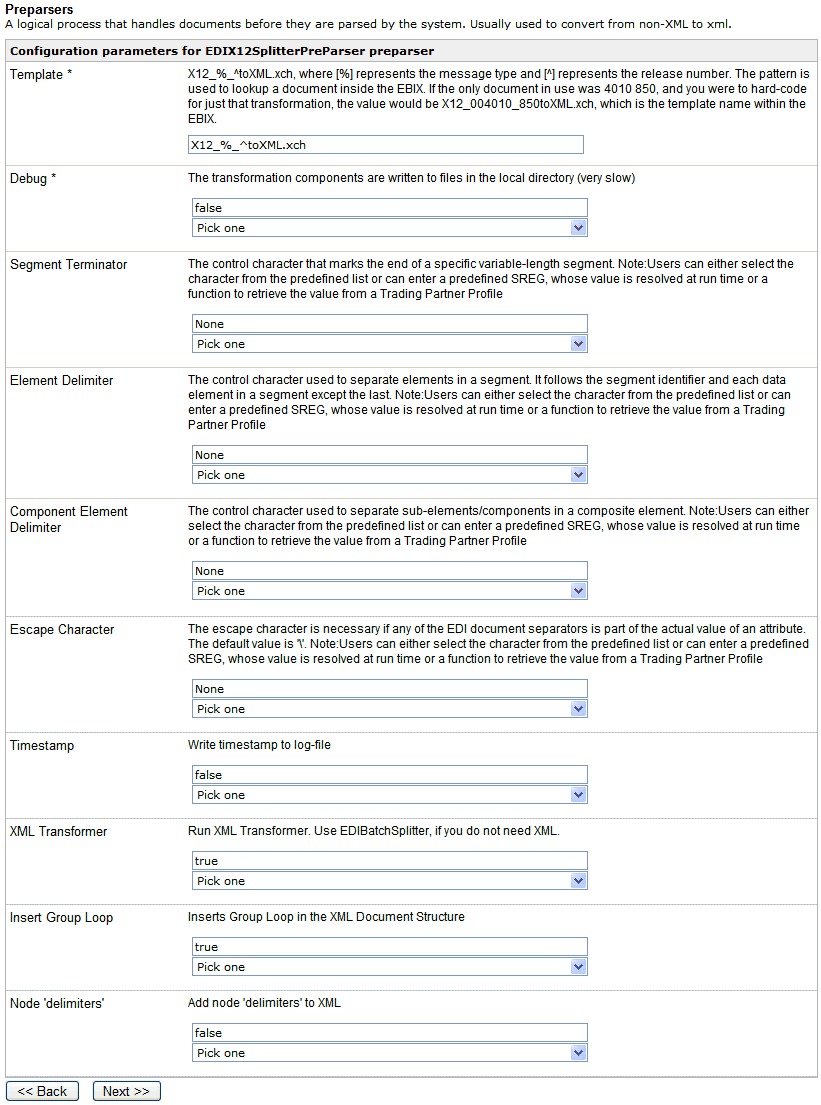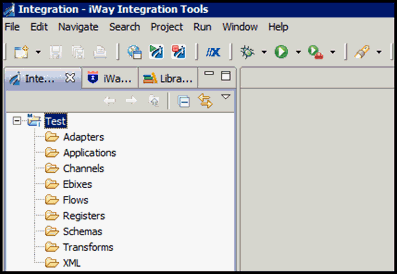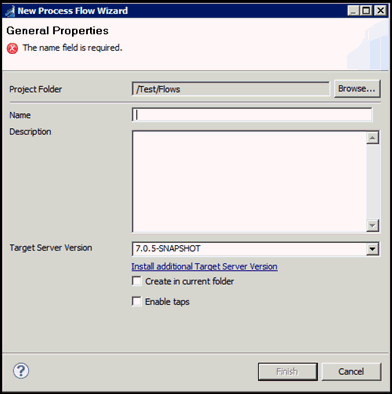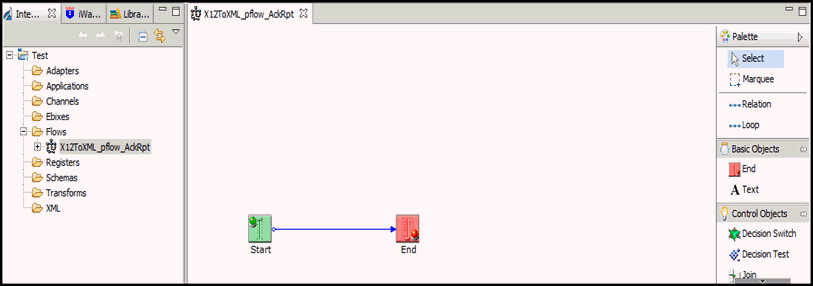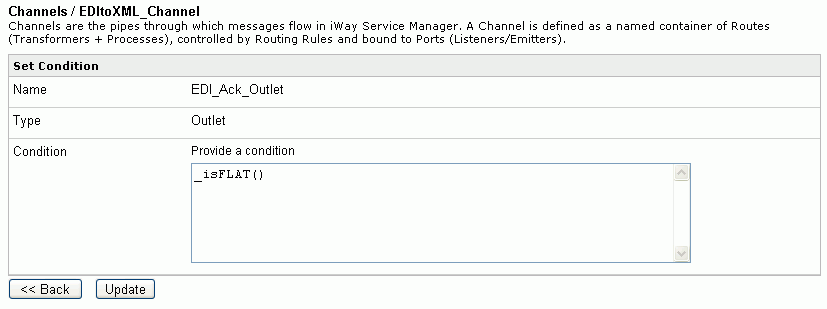-
Drag and drop the Service object from the toolbar
to the workspace, as shown in the following image.
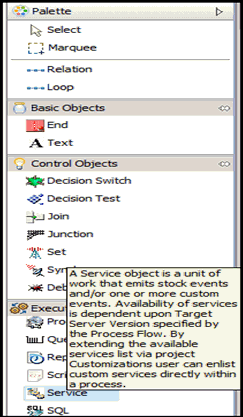
The New Service Object
dialog box opens.
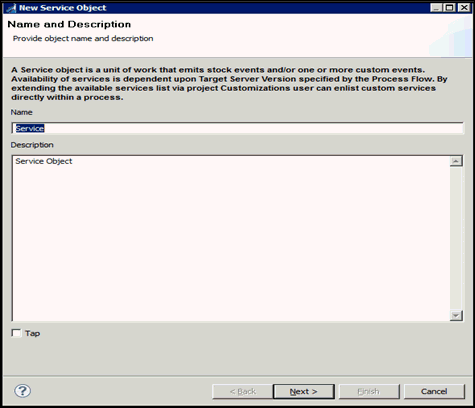
-
In the Name field, type X12_Validation_Rpt, and
a brief description (optional) in the Description field and click Next.
The Service Object Type wizard opens.
-
Select Class Name and enter com.ibi.agents.XDX12ValidationReportAgent and
click Next, as shown in the following image.

-
Click Finish.
The new Service object (X12_Validation_Rpt) appears in
the workspace.
-
Remove the relation (link) between the Start and End objects.
-
Establish new relation from the Start object to X12_Validation_Rpt
by selecting the Start object, right-clicking on the X12_Validation_Rpt
object, and then selecting Create Relation from
the context menu, as shown in the following image.

The Relation Properties
wizard opens.
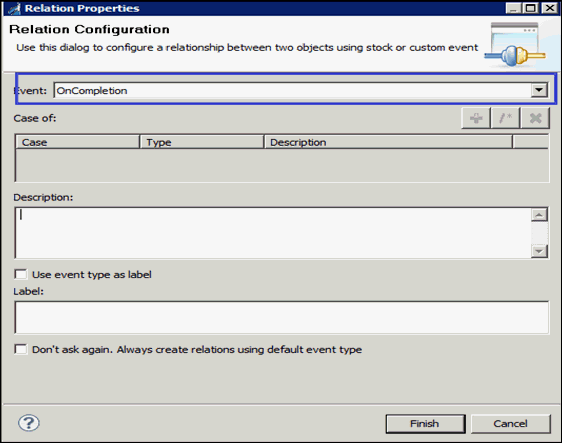
-
From the Event drop-down list, select OnCompletion and
then click Finish.
This option indicates that there are no conditions that
affect the path, and that the path between the two objects will
always be followed.
A line appears between the objects to
indicate that a relationship has been established, as shown in the
following image.
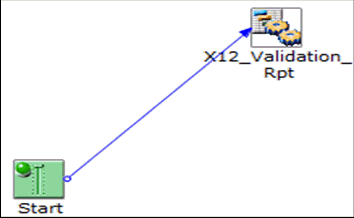
-
Drag and drop the File object from the object palette
to the workspace.
The File Type dialog box opens.
-
In the Name field, type Write_Validation_rpt, and
a brief description (optional) in the Description field and click Next.
The File Type dialog box opens.
-
From the Type drop-down list, select File
Emit Agent and click Next.
-
For the Target Directory parameter, enter a location
where validation report data will be written, for example, sreg(X12.ValidRpt).
-
For the File Pattern parameter, enter sreg(basename)_rpt.xml.
-
For the Return parameter, select input from the
drop-down list and click Finish, as shown
in the following image.
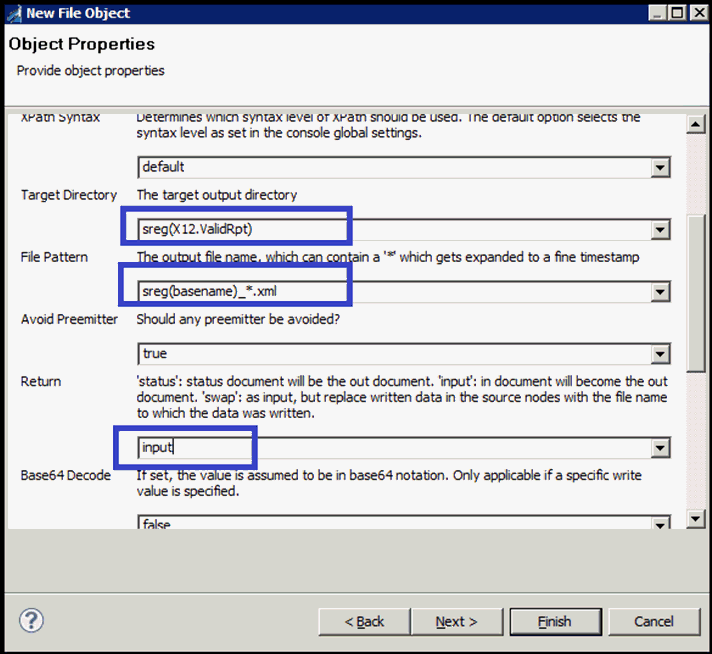
The new File object
(Write_Validation_rpt) appears in the workspace.
-
Select the X12_Validation_Rpt object,
right-click the Write_Validation_rpt object,
and select Create Relation from the context
menu.
The Line Configuration dialog box opens.
-
From the Event drop-down list, select OnSuccess and
click OK.
A line appears between the objects to indicate that a relationship
has been established.

-
Drag and drop the End object from the Object palette
to the workspace.
The End Name and Description dialog box opens.
-
In the Name field, type End3,
and a brief description (optional) in the Description field and
click Next.
The End Name Schema dialog box opens.
-
From the Terminate parameter, select the check box for
Select if this end object is the completion point,
as shown in the following image.
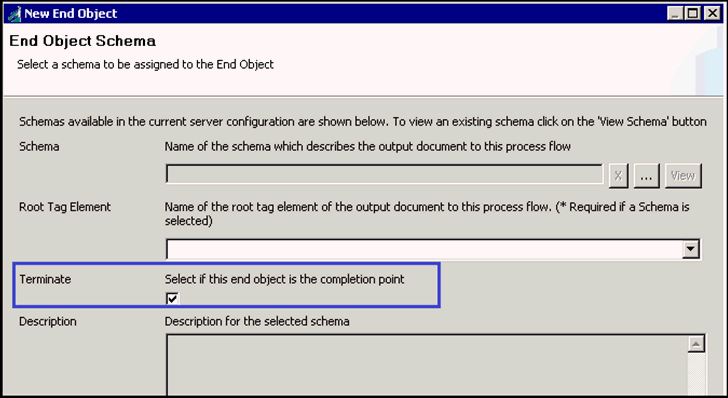
-
Click Finish.
-
Select the Write_Validation_rpt Dir object,
right-click the End3 object, and select Create Relation from
the drop-down list.
The Relation Configuration wizard opens.
-
From the Event drop-down list, select OnCustom and
then select the following check boxes:

-
Click Finish.
A line appears between the objects to indicate that a relationship
has been established, as shown in the following image.
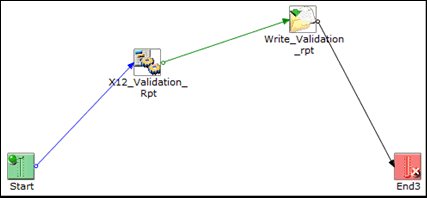
-
Select the X12_Validation_Rpt object,
right-click the End3 object, and then select Create Relation from
the drop-down list.
The Relation Configuration wizard opens.
-
From the Event drop-down list, select OnFailure and
click Finish.
A line appears between the objects to indicate that a relationship
has been established, as shown in the following image.
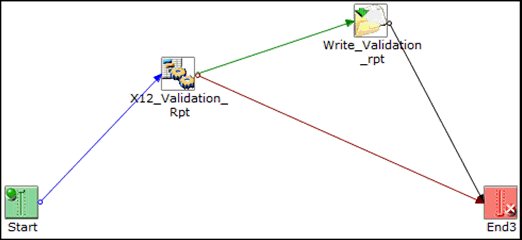
-
Drag and drop the Service object from the Object palette
to the workspace.
The New Service Object dialog box opens.
-
In the Name field, type X12AckAgent,
and a brief description (optional) in the Description field and
click Next.
The Service Type dialog box opens.
-
Select Class Name and enter com.ibi.agents.XDX12AckAgent and
click Next.
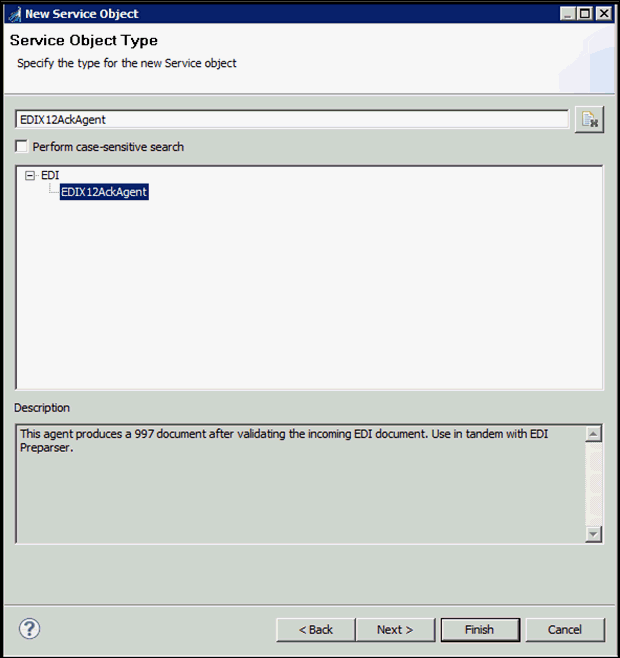
The Properties dialog
box opens. The configuration parameters for EDIX12AckAgent are displayed.
The following table lists and describes the configuration parameters.
|
Parameter
|
Description
|
|---|
|
Protocol
|
Protocol on which to make acknowledgment copies.
Select one of the following options from the drop-down list:
|
|
Location
|
Location for acknowledgment
copies.
|
|
End Tag
|
The surrounding XML tag.
|
|
Preemitter
|
Determines whether the preemitter
should be run on acknowledgment output.
|
|
Error
|
Determines whether to send
an error.
|
|
ISA Control Number
|
Element location of ISA control
number. Select one of the following locations from the drop-down
list:
- Input Document
- _SReg(edi.ICN)
|
|
GS Control Number
|
Element location of GS control
number. Select one of the following locations from the drop-down
list:
- Input Document
- _SReg(edi.GCN)
|
|
ST Control Number
|
Element location of ST control
number. Select one of the following locations from the drop-down
list:
- Input Document
- _SReg(edi.MCN)
|
|
Stream Acknowledgment
|
Determines the level of acknowledgment information
to return. Select one of the following acknowledgment levels from
the drop-down list:
-
Group. Returns acknowledgment
information at the Group level.
-
Interchange. Returns acknowledgment information at the Interchange
level.
-
Transaction. Returns acknowledgment information at the Transaction
level.
|
-
Configure the available parameters according to your requirements.
-
Click Finish.
The new Service object (X12AckAgent) appears in the workspace.
-
Select the Start object, right-click
the X12AckAgent object, and select Create Relation from
the context menu.
The Line Configuration dialog box opens.
-
From the Event drop-down list, select OnCompletion and
click OK.
A line appears between the objects to indicate that a relationship
has been established.
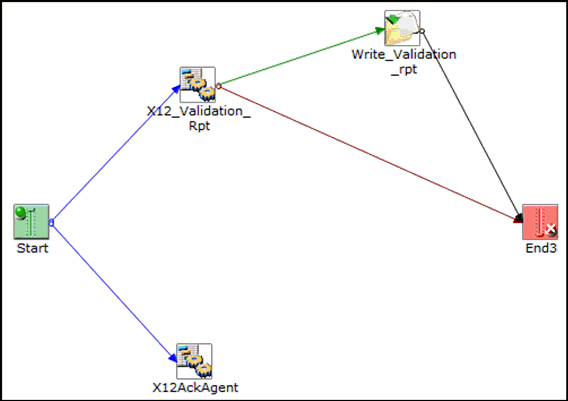
-
Drag and drop the File object from the Object palette
to the workspace.
The New File Object wizard opens.
-
In the Name field, type Write_Ack,
and a brief description (optional) in the Description field and
click Next.
The File Object Type wizard opens.
-
From the Type drop-down list, select File
Emit Agent {com.ibi.agents.XDFileEmitAgent} and then
click Next.
The Object properties wizard opens.
-
In the Target Directory field, enter a valid physical
folder location to write Acknowledgements data, for example, sreg(X12.Ack),
as shown in the following image.
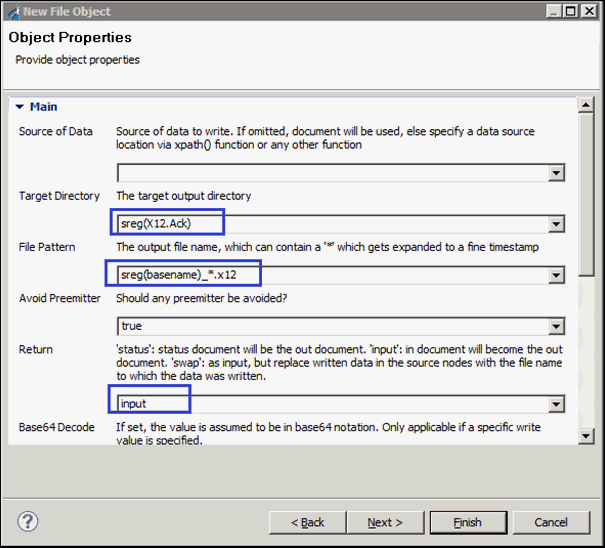
-
In the File Pattern parameter, enter sreg(basename)_*.x12).
-
For the Return parameter, select input from the
drop-down list and click Finish.
The new File object (Write_Ack) appears in the workspace.
-
Select the X12AckAgent object,
right-click the Write_Ack file object, and
select Create Relation from the context menu.
-
From the Event drop-down list, select OnSuccess and
click Finish.
A line appears between the objects to indicate that a relationship
has been established, as shown in the following image.
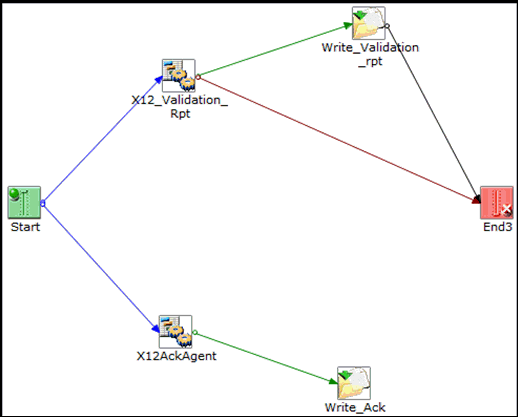
-
Drag and drop the End object from the Object palette
to the workspace.
The End Name and Description dialog box opens.
-
In the Name field, type End_Ack,
and a brief description (optional) in the Description field and
click Next.
The End Object Schema wizard opens.
-
From the Terminate parameter, select the check box for
Select if this end object is the completion point.
-
Click Finish to accept the default
values and close the dialog box.
The new End_Ack object appears in the workspace.
-
Select the Write_Ack object, right-click
the End_Ack object, and select Create Relation from
the context menu.
The Relation Configuration wizard opens.
-
From the Event drop-down list, select OnSuccess and
click Finish.
A line appears between the objects to indicate that a relationship
has been established.
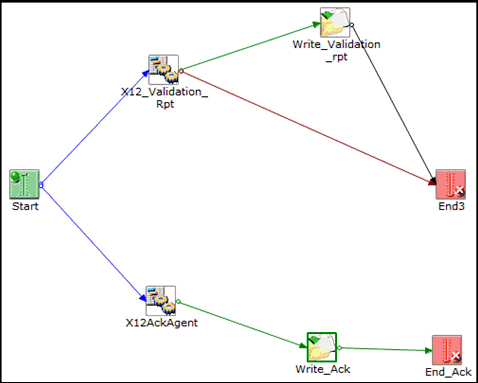
-
Select the X12AckAgent object,
right-click the End3 object (which is already
linked with the X12_Validation_rpt and Write_Validation_rpt objects),
and select Create Relation from the context
menu.
The Relation Configuration wizard opens.
-
From the Event drop-down list, select OnCustom and
select the following cases from the case parameter list:
-
Click Finish.
-
Select the Write_Ack object, right-click
the End3 object (which is already linked
with the X12_Validation_rpt and Write_Validation_rpt objects), and
select Create Relation from the context menu.
The Relation Configuration wizard opens.
-
From the Event drop-down list, select OnCustom and
select the cases from the case parameter list, as shown in the following
image:
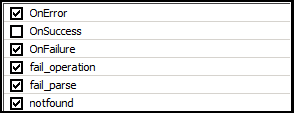
A line appears between
the objects to indicate that a relationship has been established.
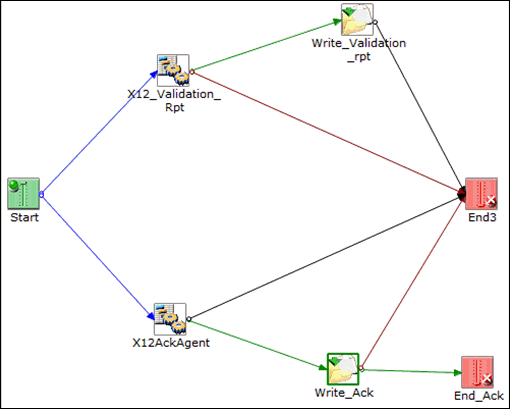
-
Drag and drop the Decision Switch object from the Objects
palette to the workspace.
The New Decision Switch Object wizard opens.
-
In the Name field, type a relevant name (for example, Decision_switch),
and a brief description (optional) in the Description field and
click Next.
-
Type the following expression in the Expression parameter:
XPATH(count(//documents/ValidationReport/Report/Success))

This will check if
the validation report is successful or not. If the validation report returns
a success node, then the incoming data will go to the Good File
write. Otherwise, it will go with the error route to write the error
file write.
-
Click Next.
-
Add new Switch Cases (1 and 0) by clicking on the Add (+)
button shown in the Switch Cases wizard.
You can delete default empty and null cases
from the cases list.
The following image shows the Switch
Cases configuration wizard showing the two cases (1 and 0) in the
switch cases list.
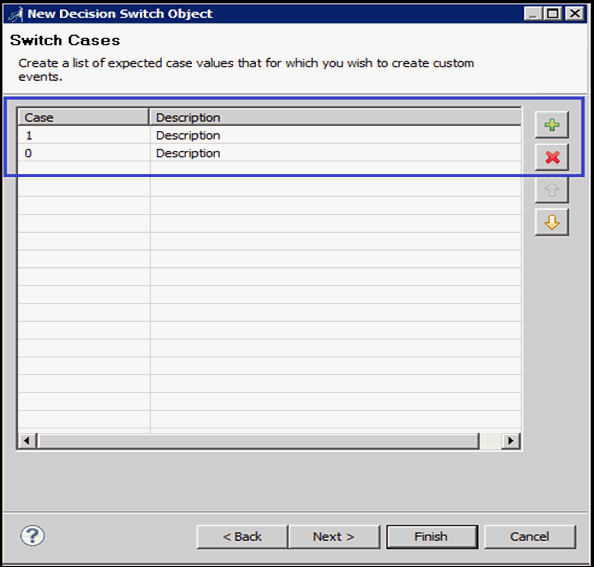
-
Click Finish to complete creating
the Switch Cases.
The new Decision Switch case object appears in the workspace.
-
Select the Write_Validation_rpt object,
right-click the switch case (Decision Switch)
object, and select Create Relation from the
context menu.
-
From the Event drop-down list, select OnSuccess and
click Finish.
A line appears between the objects in the workspace to
indicate that a relationship has been established.
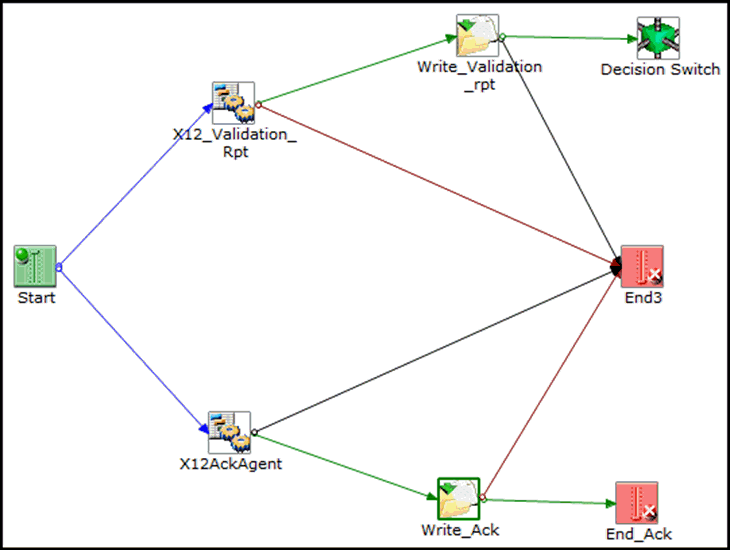
-
Drag and drop the Service object from the Object palette
into the workspace.
-
In the Name field, type XDXMLExtract,
and a brief description (optional) in the Description field and
click Next.
The Service Object Type wizard opens.
-
In the Service Object Type dynamic search box, enter
the following class name:
com.ibi.agents.XDXMLExtract
-
Select the XML Extract agent object
and click Next, as shown in the following
image.
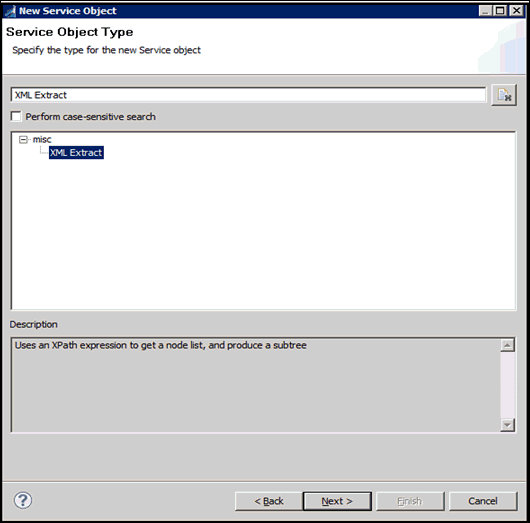
-
Provide the XPATH expression (for example, XPATH(//documents/output)
to extract the node lists from the XML, and click Finish.
Note: This is not the xpath function.
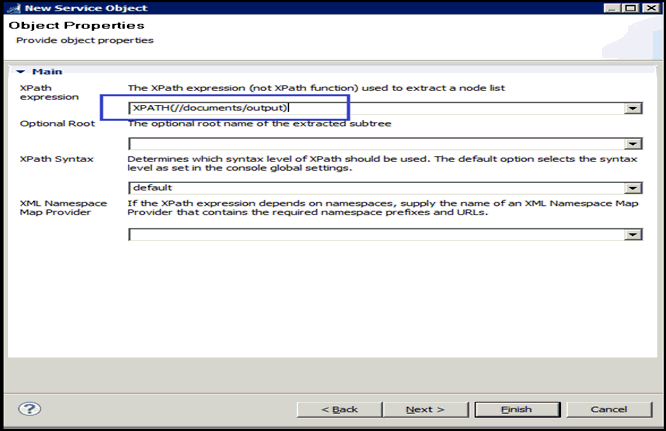
-
Create a copy of XDXMLExtract and name it as XDXMLExtract1 for
non-success validation reports (error route).
-
Select Decision Switch, right-click
on XDXMLExtract, and select Create Relation from
the context menu.
The Relation Configuration wizard opens.
-
From the Event drop-down list, select OnCustom.
-
In the Case of section in the Relation Configuration
wizard, select case 1 and then click Finish.
A line appears between the Decision Switch and XDXMLExtract
objects to indicate that a relationship has been established.
-
Select Decision Switch, right-click
on XDXMLExtract1, and select Create Relation from
the context menu.
The Relation Configuration wizard opens.
-
From the Event drop-down list, select OnCustom.
-
In the Case of section in the Relation Configuration
wizard, select the following cases:
- OnError
- OnSuccess
- OnDefault
- 0 (Zero)
All cases except case 1 should have been
selected.
-
Click Finish.
A new relation line appears between the Decision Switch
and XDXMLExtract1 objects to indicate that a relationship has been
established, as shown in the following image.
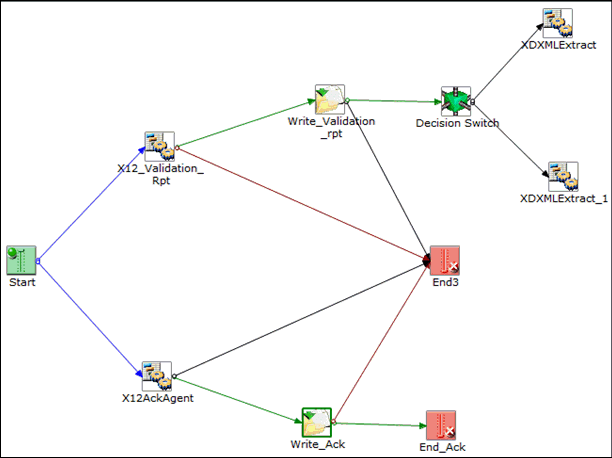
-
Drag and drop the Service object from the Object palette
into workspace.
-
In the Name field, type XDDocUpdate,
and a brief description (optional) in the Description field.
-
Click Next.
The Service Object Type wizard opens.
-
In the dynamic search box, enter the class name (for
example, com.ibi.agents.XDDocUpdateAgent), select any one
of the Doc Update Agent options and then
click Next, as shown in the following image.
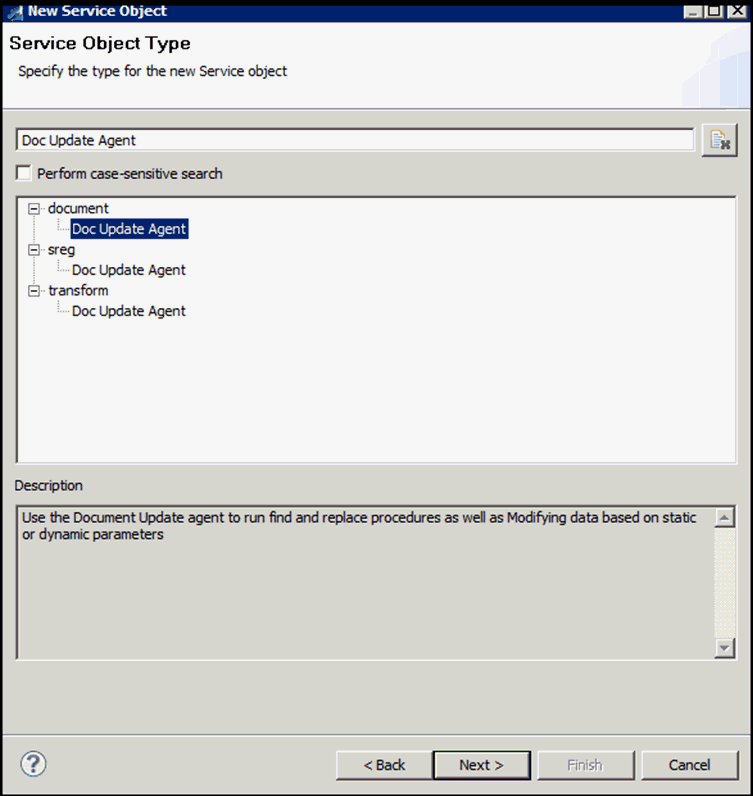
-
In the Object properties wizard, select Only Find/Replace from
the drop-down list for the Processing Method parameter in the Object
properties wizard, as shown in the following image.
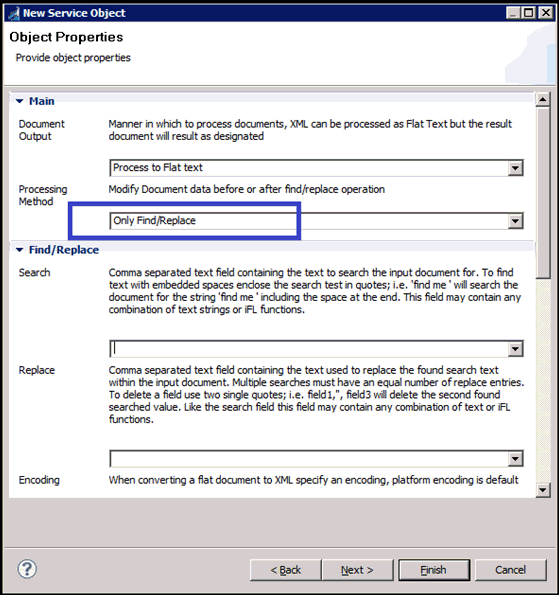
-
For the Search parameter, enter the following string
with single quotes:
'<output>','</output>'
-
For the Replace parameter, enter the following string
with double quotes:
“‘”
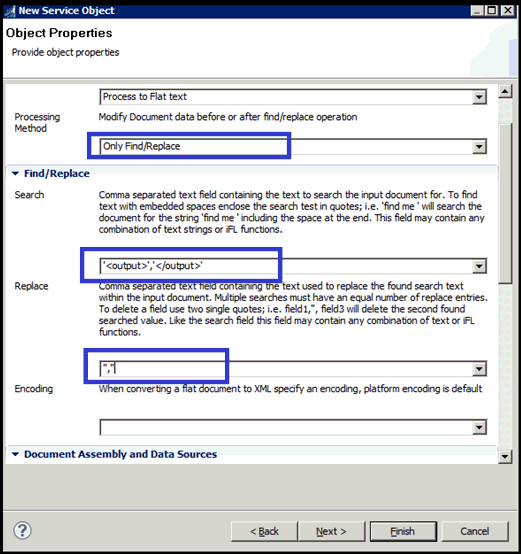
-
Click Finish to complete creating
the Doc Update Agent.
The XDDocUpdate object appears in the workspace.
-
Create a copy of the XDDocUpdate agent and name it as XDDocUpdate1 for
the non-success validation report (error route).
-
Select XDXMLExtract, right-click
the XDDocUpdate agent, and select Create Relation from
the context menu.
-
From the Event drop-down list, select OnSuccess and
click Finish.
-
Select the XDXMLExtract1 object,
right-click on the XDDocUpdate1 object, and
select Create Relation from the context menu.
-
From the Event drop-down list, select OnSuccess and
click Finish.
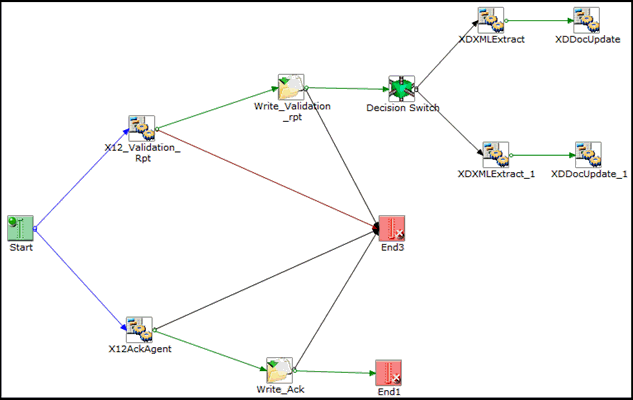
-
Drag and drop the File object from the object palette
to the workspace.
The New File Object wizard opens.
-
In the Name field, type Good File, and a brief
description (optional) in the Description field, and then click Next.
The File Object Type wizard opens.
-
From the Type drop-down list, select File
Emit Agent {com.ibi.agents.XDFileEmitAgent} and click Next.
The Object properties wizard opens.
-
For the target directory, enter a valid physical folder
location to write Acknowledgements data, for example:
sreg(X12.GoodOutput)
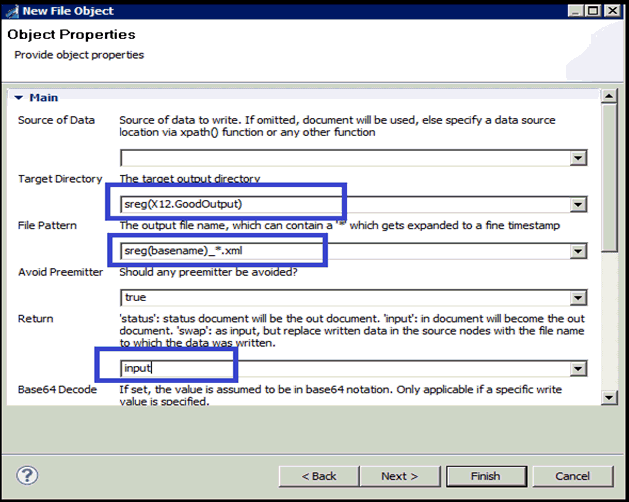
-
In the File Pattern parameter, enter the following:
sreg(basename)_*.xml
-
In the Return parameter, select input from
the drop-down list, and then click Finish.
The new File object (Good File) appears in the workspace.
-
Select the XDDocUpdate object,
right-click the Good File object, select Create Relation from
the context menu, and then click Next.
-
From the Event drop-down list, select OnSuccess and
then click Finish.
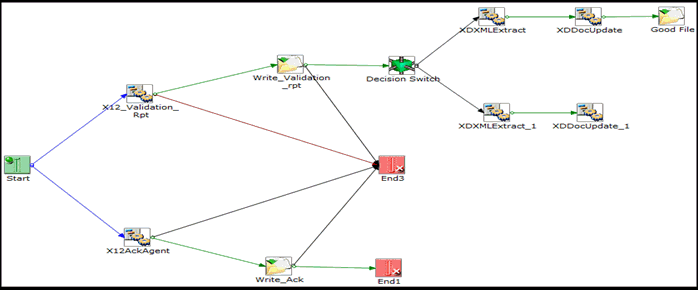
-
Drag and drop the File object from the Object palette
to the workspace.
The New File Object wizard opens.
-
-
In the Name field, type Bad File, then enter a
brief description (optional) in the Description field and click Next.
The File Object Type wizard opens.
-
From the Type drop-down list, select File
Emit Agent {com.ibi.agents.XDFileEmitAgent} and click Next.
The Object Properties wizard opens.
-
In the Target Directory field, enter a valid physical
folder location to write Acknowledgements data. For example:
sreg(Hipaa.BadOutput)
-
In the File Pattern paremeter, enter the following:
sreg(basename)_*.xml
-
In the Return parameter, select input from
the drop-down list and then click Finish,
as shown in the following image.
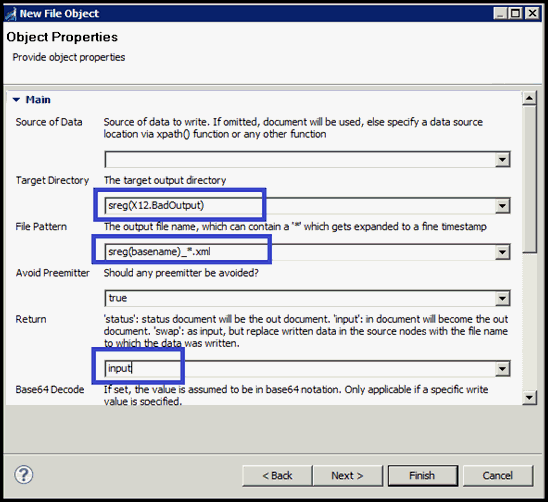
The new File object
(Bad File) appears in the workspace.
-
Select the XDDocUpdate1 object,
right-click the Bad File object, and select Create Relation from
the context menu.
-
Click Next.
-
From the Event drop-down list, select OnSuccess and
then click Finish.
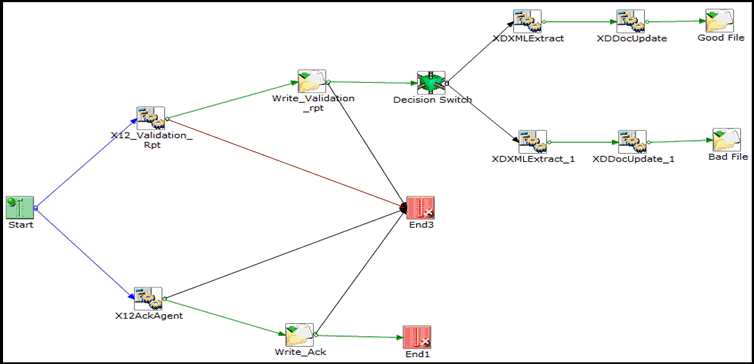
-
Drag and drop the Junction object into workspace from
the Objects palette.
-
In the Name field, enter Junction (by default
it will show Junction), and then click Finish.
The Junction object appears in the workspace.
-
Create a copy of the Junction object, name it as Junction1,
and then click Finish.
A copy of the Junction object (junction1) appears in the workspace.
-
Select the Good File object, right-click
the Junction object, and select Create Relation from
the drop-down list.
The Relation Configuration wizard opens.
-
From the Event drop-down list, select OnSuccess and
click Finish.
A relation (line) appears between Good File and the Junction object.
-
Select the Bad File object, right-click
the Junction object, and select Create Relation from
the context menu.
The Relation Configuration wizard opens.
-
From the Event drop-down list, select OnSuccess and
click Finish.
A line appears between the objects to indicate that a relationship
has been established, as shown in the following image.
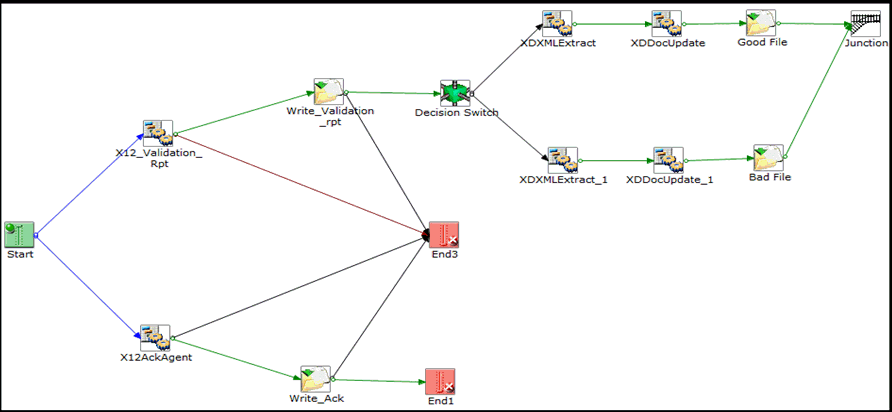
-
Select the Good File object, right-click
on the Junction1 object, and then select
the Create Relation option from the context
menu.
The Relation Configuration wizard opens.
-
From the Event drop-down list, select OnCustom and
then select following cases from the case parameter list:
- OnError
- OnFailure
- Fail_operation
- Fail_parse
- notfound
A relation (line) appears between Good
File and the Junction1 objects.
-
Select the Bad File object, right-click
on the Junction1 object, and then select
the Create Relation option from the context
menu.
The Relation Configuration wizard opens.
-
From the Event drop-down list, select OnCustom and
then select following cases from the case parameter list:
- OnError
- OnFailure
- Fail_operation
- Fail_parse
- notfound
A relation (line) appears between Bad File
and the Junction1 objects, as shown in the following image.
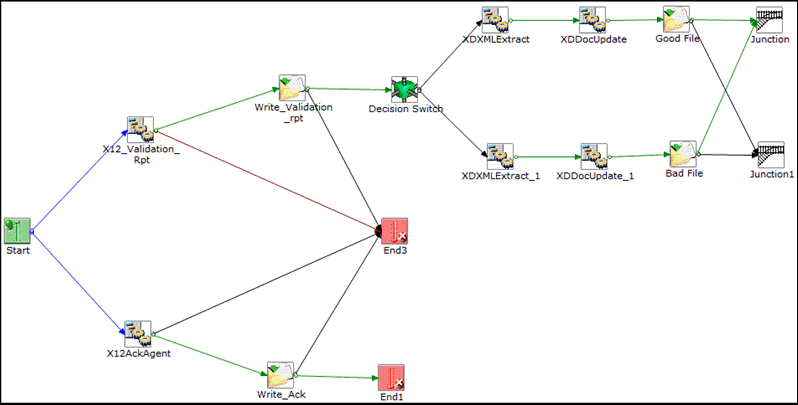
-
Drag and drop the End object from the Object palette
to the workspace.
The End Name and Description properties wizard opens.
-
In the Name field, type End, then enter a brief
description (optional) in the Description field and click Next.
The End Object Schema wizard opens.
-
From the Terminate parameter, select the check box for Select
if this end object is the completion point.
-
Click Finish.
The new End object appears in the workspace.
-
Select the Junction object, right-click
on the End object, and then select the Create Relation option
from the context menu.
-
From the Event drop-down list, select OnCompletion and
then click Finish.
A new Relation (line) appears between the Junction object
and the End object, as shown in the following image.
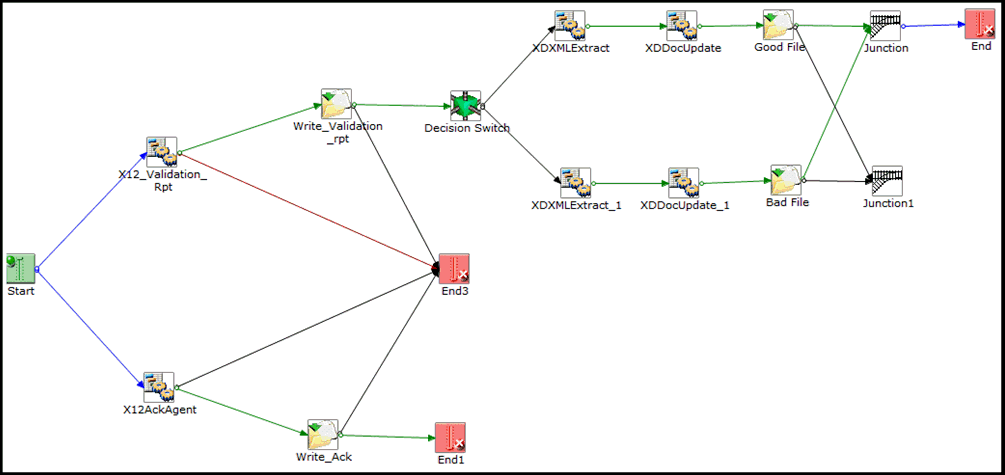
-
Drag and drop the End object from the Object palette
to the workspace.
The End Name and Description properties wizard opens.
-
In the Name field, type End2, then enter a brief
description (optional) in the Description field and click Next.
The End Object Schema wizard opens.
-
From the Terminate parameter, select the check box for Select
if this end object is the completion point.
-
Click Finish.
The new End2 object appears in the workspace.
-
Select the Junction1 object, right-click
on the End2 object, and then select the Create Relation option
from the context menu.
-
From the Event drop-down list, select OnCompletion and
then click Finish.
A new Relation (line) appears between the Junction1 object
and the End2 object, as shown in the following image.

The process flow is
now complete.
-
To save the process flow, click the File menu and then
select Save from the File menu options.
Now you need to validate the process flow and publish it
to the Registry of the iWay Service Manager Administration Console
for use in the route of a channel for outbound processing.
Validating
a process flow ensures that its structure is correct. Publishing
a process flow makes it available in the Registry for use in a channel
configuration. For instructions on validating and publishing the
process flow, see the iWay Integration Tools Designer User's
Guide.
-
Close iIT Designer.
Your next step is to add a new route to the Registry using
the iWay Service Manager Administration Console and associate the
process flow with it.

